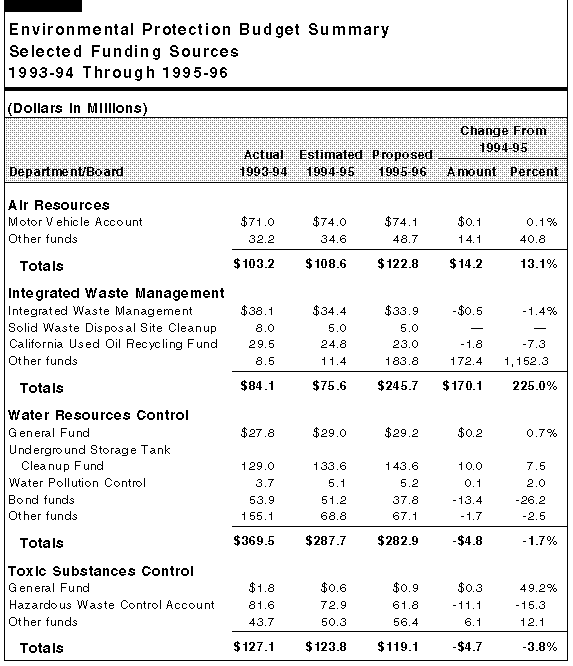Legislative Analyst's Office
February 22, 1995

Expenditures for resources and environmental protection programs are proposed to total $2.1 billion in 1995-96, which is 3.7 percent of all state funded expenditures proposed for 1995-96. This level is a slight decrease of approximately $12.3 million, or 0.6 percent, below estimated expenditures for the current year. About 59 percent ($1.2 billion) of state support for these programs will come from special funds, including the Motor Vehicle Account, Environmental License Plate Fund, funds generated by beverage container recycling fees, and an insurance fund for the cleanup of leaking underground tanks. The General Fund supports the remaining 41 percent of these expenditures.
Figure 1 (see next page) shows that resources and environmental protection expenditures from all state funds increased by approximately $791 million since 1988- 89, representing an average annual increase of approximately 7.1 percent. This increase primarily reflects the establishment of various programs to address environmental problems such as leaking underground tanks, hazardous waste sites, and solid waste generation. When adjusted for inflation, these expenditures increased at an average annual rate of 3.9 percent. General Fund expenditures increased at an average annual rate of 2 percent over this period. When these expenditures are adjusted for inflation, however, General Fund support has declined slightly since 1988-89.

Figure 2 shows spending for major resources programs that is, those programs within the jurisdiction of the Secretary for Resources.


Figure 3 shows similar information for four major environmental protection programs those programs within the jurisdiction of the Secretary for Environmental Protection and the Cal-EPA.

Spending for Resources Programs. Figure 2 shows that of the major resources programs, the Department of Water Resources will have the highest expenditure level in 1995-96, at $971.7 million. Most of the department's expenditures will be for the expansion of the state water project.
Figure 2 also shows that the General Fund provides a relatively small proportion of total support of resources programs except in the case of the Department of Forestry and Fire Protection (CDFFP) and the Department of Parks and Recreation (DPR). In 1995-96, the General Fund will contribute $302 million (67 percent) of the CDFFP's budget. For the DPR, the General Fund will constitute about 23 percent of the department's expenditures in 1995-96.
Figure 2 also reflects significant decreases in the 1995-96 expenditures of the Department of Conservation (DOC). This is because the Governor's Budget proposes to consolidate most of its activities with those of the Energy Commission into a new Department of Energy and Conservation (not shown in figure), beginning in January 1996. Also as part of the reorganization proposal, the budget proposes to transfer the Beverage Container Recycling program from the DOC to the California Integrated Waste Management Board (CIWMB) beginning in 1996. (This accounts for the significant increase in the CIWMB's expenditures shown in Figure 3.)
Spending for Environmental Protection Programs. As Figure 3 shows, the State Water Resources Control Board (SWRCB) is the largest environmental protection program, with proposed expenditures of $282.9 million for 1995-96, slightly lower than the current year level. The figure also shows that the budget proposes a reduction in the funding level for the Department of Toxic Substances Control (DTSC) in order to adjust for overly optimistic revenue projections in past years.
As Figure 3 also shows, the budget proposes an increase of $14 million in the Air Resources Board (ARB), and an increase of $170 million in the CIWMB for 1995-96. In the case of the ARB, the increase will provide funds to reimburse the repair costs of engines damaged as a result of the use of reformulated diesel fuel. In the case of the CIWMB, the increase reflects the budget proposal to transfer the Beverage Container Recycling program from the DOC to the board.
Figures 4 (page 10) and 5 (page 11) present the major budget changes in resources and environmental protection programs, respectively. As Figure 4 shows, the budget proposes a $10 million General Fund increase for the CDFFP to retrofit airtankers. The budget also proposes to increase funding for emergency fire suppression by $20 million.



For the DPR, the budget proposes to use $19.4 million from the California Beverage Container Recycling Fund to support the department's operations. This is in part offset by a reduction of $10.4 million from the Harbors and Watercraft Revolving Fund. Additionally, the budget proposes a reduction of $34.6 million in local assistance for park activities and $33.7 million in capital outlay expenditures.
For the Department of Water Resources, the budget proposes to reduce local assistance for various activities by $56.1 million, mainly as a result of the depletion of bond funds. Activities affected include development of safe drinking water projects, flood control, and formulation of the California Water Plan.
Figure 5 shows that the budget proposes an increase of $14 million in ARB expenditures to reimburse the repair costs for damage of engines resulting from the use of reformulated diesel fuel mandated by the board. As pointed out earlier, the budget proposes to transfer the Beverage Container Recycling program to the CIWMB , and proposes half-year funding of $172.2 million to that program in 1995-96.
For the SWRCB, the budget proposes an increase of $10 million to handle additional claims workload and payments in the Underground Storage Tank Cleanup program. The budget also requests $12.3 million less for local assistance for water reclamation, and for the construction of wastewater treatment and storm drainage facilities, because of a lack of bond funds.
Figure 5 also shows that the budget proposes $4.1 million for the DTSC to establish an expedited site remediation pilot program, and $2.3 million to oversee cleanup of military bases. The budget also proposes to reduce the funding of various programs of the department and other state agencies from the Hazardous Waste Control Account by $11.4 million to adjust for past overestimation of revenues, and to free up resources for new programs.